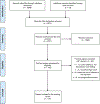School-based obesity prevention programs in rural communities: a scoping review
- PMID: 36513382
- PMCID: PMC10278058
- DOI: 10.11124/JBIES-21-00233
School-based obesity prevention programs in rural communities: a scoping review
Abstract
Objective: The objective of this review was to examine existing literature and conceptually map the evidence for school-based obesity prevention programs implemented in rural communities, as well as identify current gaps in the literature.
Introduction: Pediatric obesity is a significant public health condition worldwide. Rural residency places children at increased risk of obesity. Schools have been identified as an avenue for obesity prevention in rural communities.
Inclusion criteria: We considered citations focused on children (5 to 18 years of age) enrolled in a rural educational setting. We included obesity prevention programs delivered in rural schools that focused on nutrition or dietary changes, physical activity or exercise, decreasing screen time, or combined nutrition and physical activity that aimed to prevent childhood obesity. We included all quantitative, qualitative, and mixed methods research designs, as well as text and opinion data.
Methods: A search was conducted of published and unpublished studies in English from 1990 through April 2020 using PubMed, CINAHL Complete, ERIC, Embase, Scopus, Academic Search Premier, Cochrane Register of Controlled Trials, and ClinicalTrials.gov. Gray literature was also searched. After title and abstract review, potentially relevant citations were retrieved in full text. The full texts were assessed in detail against the inclusion criteria by 2 independent reviewers. Included citations were reviewed and data extracted by 2 independent reviewers and captured on a spreadsheet targeting the review objectives.
Results: Of the 105 studies selected for full-text review, 72 (68.6%) were included in the final study. Most of the studies (n = 50) were published between 2010 and 2019 and were conducted in the United States (n = 57). Most studies included children in rural elementary or middle schools (n = 57) and targeted obesity prevention (n = 67). Teachers implemented the programs in half of the studies (n = 36). Most studies included a combination of physical activity and nutrition components (n = 43). Other studies focused solely on nutrition (n = 9) or physical activity (n = 9), targeted obesity prevention policies (n = 9), or other components (n = 8). Programs ranged in length from weeks to years. Overall, weight-related, physical activity-specific, and nutrition-specific outcomes were most commonly examined in the included citations.
Conclusions: Obesity prevention programs that focused on a combination of physical activity and nutrition were the most common. Multiple outcomes were examined, but most programs included weight-specific and health behavior-specific outcomes. The length and intensity of rural school-based obesity prevention programs varied. More research examining scientific rigor and specific outcomes of rural school-based obesity prevention programs is needed.
Copyright © 2022 JBI.
Conflict of interest statement
The authors declare no conflict of interest.
Figures
References
-
- Bauman A, Rutter H, Baur L. Too little, too slowly: International perspectives on childhood obesity. Public Health Res Pract 2019;29(1):1–5. - PubMed
-
- Daniels SR. The consequences of childhood overweight and obesity. Future Child 2006;16(1):47–67. - PubMed
-
- Morrison KM, Shin S, Tarnopolsky M, Taylor VH. Association of depression & health related quality of life with body composition in children and youth with obesity. J Affect Disord 2015;172:18–23. - PubMed
-
- Schwimmer JB, Burwinkle TM, Varni JW. Health-related quality of life of severely obese children and adolescents. JAMA 2003;289(14):1813–9. - PubMed
Appendix II: Studies ineligible following full-text review
-
- Hosseini H, Yilmaz A. Using telehealth to address pediatric obesity in rural Pennsylvania. Hosp Top. 2019;97(3):107–18. - PubMed
-
Reason for exclusion: ineligible concept – no outcomes reported
-
- Lyders S Evaluation of a daily activity program for early school-age children in a rural setting. 2019.
-
Reason for exclusion: ineligible population – adults
-
- Marchetti D, Fraticelli F, Polcini F, Fulcheri M, Mohn AA, Vitacolonna E. A school educational intervention based on a serious game to promote a healthy lifestyle. Mediterranean J Clin Psychol. 2018;6(3):1–16.
-
Reason for exclusion: ineligible context – both rural and urban settings
Publication types
MeSH terms
Grants and funding
LinkOut - more resources
Full Text Sources
Medical
Miscellaneous


